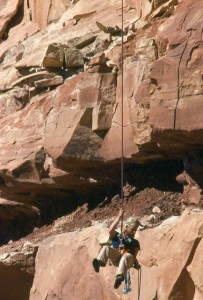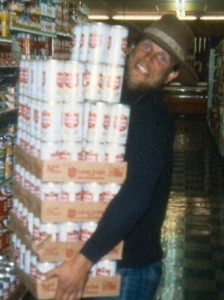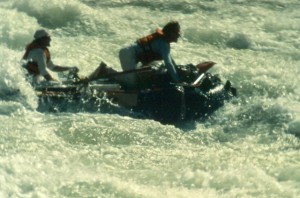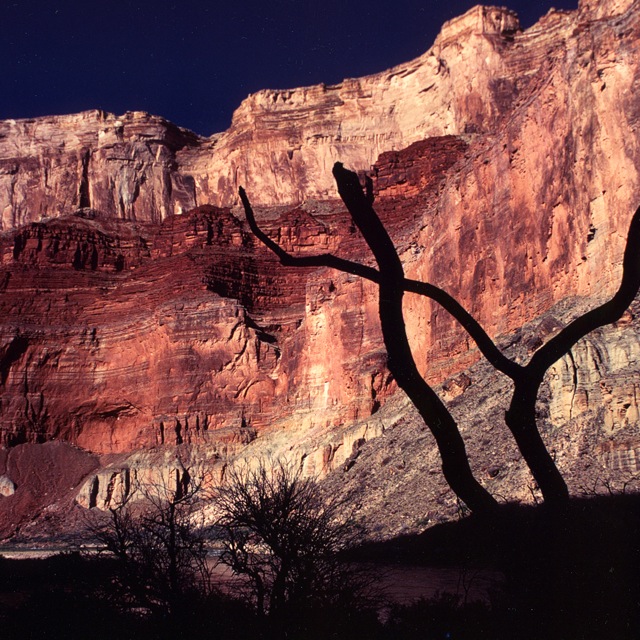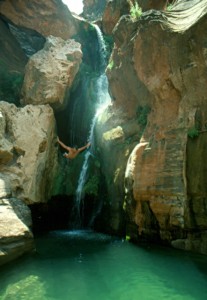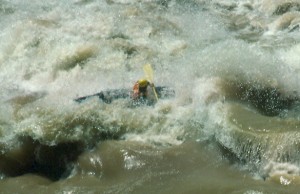How Kayaking Ruined my Climbing Career
“Heaven is under our feet as well as over our heads.” — Henry David Thoreau
This story is dedicated to the memory of Mark Gunderson, who was a great artist and one of the most entertaining people that I have met. We shared many adventures, but this trip down the Grand Canyon was about as good as it gets, and his humor kept us all entertained. He fought a good battle in life and left many good memories, but the cancer won. He is deeply missed by his family and many friends, but his paintings and his spirit will always be with us.
Little Buddy had been trying to talk me into kayaking for over a year, and he had tried to drown me on two occasions during some rolling sessions at a local swimming pool. I preferred the frozen crystals of water to the liquid variety, I didn’t really like water, and the idea of bouncing upside down over rocks in an icy stream didn’t really interest me.
We had just finished a seven-day climbing trip in the Grand Canyon and had climbed three classic spires — the South Face of Zoroaster Temple and two previously unclimbed towers in the Angels Gate group. The food for the expedition consisted of meager rations of mac-and-cheese dinners, and I was very anxious for a real meal and some beer, so I quickly signed my name and headed for the restaurant.
Six months later, I received a letter from the National Park Service. “Mr. Mattson: You are currently number 568 on the waiting list for a private permit for the Colorado River through Grand Canyon National Park. You may apply for a launch date next year if you wish, but if you wait one more year, the chances of getting your chosen launch date will be a lot better.”
“Wow! Maybe I should try kayaking,” I thought to myself, as I wandered away from the post office. I had heard many stories about paddling the Grand Canyon when I lived in Flagstaff, and the chance to organize an expedition was very enticing.
The next spring, I saw a fiberglass kayak for sale on the local bulletin board and went over to check it out. It looked like it was in reasonable shape, and it seemed to fit.
“I don’t have much money. Would you be interested in trading a pair of skis for it?” I inquired.
“Maybe, what do you have to trade?”
“How about some 207 Head Standards with Solomon bindings? They’re great powder skis.”
“I might, but I would need to see them.”
I rushed home to grab the skis, and a deal was soon made. The barter included a spray skirt, an old paddle, and an old lifejacket. My raincoat made a decent paddle jacket, and my climbing helmet had been good enough for the town downhill, so I figured that it was good enough for kayaking. If you spend all of your money for fancy stuff, you have to work all the time, and you don’t have any time to use it.
I had an old Sears four-man raft that I had purchased in college and managed to talk a couple of my friends into accompanying me on my maiden voyage. We started just above Carbondale, Colorado and paddled class II water on the Roaring Fork River into the confluence of the Colorado River in Glenwood Springs. I felt instantly at home in my new craft. The boat was quite stable and could be maneuvered very easily. I was cruising upright around the rocks instead of bouncing upside down over them, and the cold water splashing on my face was very refreshing.
We stopped for lunch on an empty beach with a fabulous view of Mount Sopris, and I felt like I had entered a hidden paradise in my own backyard.
The Roaring Fork Valley is a great place to learn how to kayak. The river offers everything from Class II to Class IV, and the nearby Colorado River offers year-round paddling on easy to extreme whitewater.
I found a kayak book in the library that showed rolling techniques, snuck into a hotel pool to practice, and took a class from the local kayak school to perfect my techniques. My climbing partner was threatening to burn my kayak because he felt neglected, but the passion was overwhelming. I had just turned thirty, but my new hobby made me feel like I was twenty once again. By the end of the summer, I was feeling fairly comfortable on Class III and decided to pick a date for my Grand Canyon trip.
Soon, a letter arrived from the National Park Service. “Mr. Mattson: The May 10 launching date that you have selected for the Grand Canyon is available. If you wish to confirm this date, please sign the enclosed letter and return it within thirty days. Your permit allows fifteen people and twenty-one days.”
“Hey Gundy! I got the permit! We are launching on May 10.”
“Yahoo! That’s awesome. I have been wanting to float that river for ten years! I’ll be ready,” he replied.
“The permit is good for fifteen people, so start recruiting. I’ll keep you posted on the logistics, and I’ll plan to be down there about a week early for the final preparations.”
I settled back to a good winter of ski racing and building cabinets for an eccentric multimillionaire who was constantly remodeling his house on Red Mountain. The pay was great, and the hours were very flexible, but the work wasn’t very satisfying.
When the ski season was over, I quit the job, placed my few, worldly belongings into a storage shed, and headed for Yosemite National Park. I had recently purchased a plastic kayak called a Perception Mirage, and I was very eager to try it out.
It was a very wet spring in California and not very good for climbing, but the Merced River was raging, and the kayakers were having a great time. The river was mostly Class III, with an optional Class IV stretch, and was a perfect place to practice. There was a huge hole in the Class IV section, which was quite easy to miss, but somehow I didn’t. It was my first big hole ride, and it felt like being stuck in a commercial washing machine on the heavy-duty cycle. The cycle surged, and I managed to swim away, but it gave me a new respect for my new found passion.
There were a few sunny days between the showers, and I managed to climb a couple of classic routes before heading to Flagstaff.
It felt good to be back in Flag, and I spent a very pleasant afternoon visiting my old friends.
“¡Hola amigo! Good to see you,” John Foss greeted me with a big smile. The yard of his old house on Fountaine Street was filled with kayaks and camping gear, and John was very busy packing. “Glad to see that you finally started kayaking,” he remarked, pointing to the Mirage. “You’re just in time to do the Salt. It’s a great three-day run, and it is flowing at a really good level. We are leaving in about an hour, and I have an extra stow float that you can use.”
The offer sounded too good to refuse, so I quickly organized my gear, and we stopped at a nearby grocery store to buy supplies for the trip.
The Salt River starts in the lush forests of the White Mountains of east-central Arizona and winds its way through a spectacular canyon as it drops into the diverse landscape of the Sonoran Desert. We traveled light and paddled a pristine, Class II-III stream with majestic scenery. The weather was clear, and we spent two incredible evenings telling stories of past adventures and enjoying the bright starlight and the gentle songs of the ever-moving river. The lush green forest gave way to a sparse desert of stately Saguaros and an assortment of other cacti that were just starting to blossom. The wet winter had provided plenty of water, and the vegetation looked very healthy.
“I wish I could go on your Grand trip, but I have to finish a project,” John lamented, as we headed back up the hill to Flagstaff. “I’m jealous, but I’ve already done it four times. It’s incredible!”
Gundy’s girlfriend, Jan, had worked for one of the local, commercial raft companies and was very helpful with the logistics. We were planning to travel all the way to Pierce Ferry on Lake Mead, which added about forty miles to the length of the standard trip. The total length of our journey would be 280 miles, and we needed food for fifteen people for twenty-three days. The food needed to be organized and labeled, so that we could find it easily on the river, and the perishable items needed to be refrigerated.
The Death Star had very little room for gear, so we decided to rent a large J-Rig from one of the local outfitters. This was a commercial raft that had been built with two army surplus pontoons and a metal frame. It was outfitted with a very large, efficient cooler and some large, dry boxes for storing food and gear. We also had two, fourteen-foot rafts for the rest of the group. The group decided that the portable toilet was the only item that we would trust the Death Star to carry.
The non-perishable food was purchased at a local, wholesale grocery store and organized in Gundy’s yard, and the large cooler was carefully packed and stored in a freezer.
The rest of the group gradually trickled into town, and the excitement mounted. We loaded up all the gear and headed north with our caravan of happy people. Somehow, all the gear managed to fit in the boats, and the excited group prepared for the launch.
The local ranger was not very impressed with the Death Star, but Gundy had done his homework and proudly produced a license for the craft. It was fourteen feet long and had two air chambers, which met the legal requirements.
“I hereby christen you the Death Star, and I hope you make it down this river, ‘cuz I don’t want to swim!” Gundy shouted cheerfully, while dribbling a little champagne on the boat and taking a huge gulp for himself.
The J-Rig was floating a bit low, but it was manned by a hearty oarsman with many years of Grand Canyon experience, so we weren’t worried. The euphoria of the moment pushed my fun meter to record levels as our joyous flotilla paddled downstream under the Navajo Bridge and into the remarkable depths of Marble Canyon. I have since run more than a hundred rivers all over the world, but the Grand Canyon is still one of my all-time favorites.
I was barely an intermediate boater, and the river was flowing about 25,000 CFS, so I proceeded cautiously with the two other kayakers on the trip. The high water actually made many of the rapids easier, but the eddy lines were very turbulent and my roll was only working about 50% of the time.
Everyone (except the J-Rig) stopped to scout Badger Creek Rapid, which was the first medium-sized drop. Bruce was very familiar with this rapid, and catching eddies with the overloaded rig was very difficult, so he rowed right down the middle and caught a large eddy at the bottom.
“That looks really scary! I might need another martini to calm my nerves!” Captain Gundy said with a chuckle, as we looked at the big, surging waves.
“Right down the middle looks like the best line. Just hold your breath, paddle hard, and try to stay close together,” I said nervously.
The line looked fairly clean, but the waves looked a lot bigger than any that I had ever paddled, and they were probably bigger than they appeared from the shore. The three kayakers paddled cautiously down the middle of the green tongue and felt our boats suddenly accelerate as we dropped into the rapid.
“Yow!” I thought to myself, as I stared at the crest of the huge wave that my boat was climbing. It was surging at the top and sent the kayak skyward, then back down into the next trough. The waves continued like a wild, roller coaster ride, and I could hear my friends whooping noisily in their excited states of mind. I managed to stay upright in the large waves, but the eddy line at the bottom of the rapid was very turbulent and tipped me over. The first roll was not successful, and neither was the second. But the third try finally worked, and I paddled into the eddy to high-five the rest of the jubilant group.
“Wow! Did you see that?” the adrenaline-stoked Captain Gundy asked. “We almost tipped over, but Ballaster Bob saved the day. I’m gonna have another martini to celebrate.”
Ballaster Bob was a professional ski racer from Aspen who had once been described as the fastest fat man in the West. When the ranger at the put-in had asked him what his function in the group was, he had replied, “ballast,” and the nickname stuck. He was the only person in the group who was brave enough to ride with Gundy, and he used his weight skillfully to keep the Death Star upright.
That was the only challenging rapid of the day, and the exuberant flotilla found a secluded beach to claim as our new home. Rafting trips are a lot like car camping and often include luxuries such as chairs, thick foam pads, gourmet food, and cocktails. The kitchen and camping gear were quickly unloaded, and the aprés-rafting party began. The spring desert air was very warm, the scenery was fabulous, and the humor flowed as freely as the beer. Gundy could have easily been a standup comedian, and his energy seemed to radiate throughout the group. We enjoyed a fabulous dinner next to a charcoal fire and watched the dark sky glisten with the sparkling lights of a few million stars.
The raging river lulled us to sleep, but the flow levels, which were controlled by a large generator upstream, started to drop about midnight. The heavy J-Rig was almost beached, but we noticed just in time and rallied enough campers to push it back into the river. I quickly fell back into a sound sleep and dreamed of kayaking through big waves and strong eddy lines.
The morning sun was very warm, and we enjoyed a relaxed breakfast in our secluded paradise before loading the boats and heading downstream. I was very eager to climb back into my boat and practice the techniques I had been dreaming about.
The crystal-clear water that we were paddling in had been trapped at the bottom of Lake Powell for most of the winter and was very cold. Practicing my roll in this icy water was invigorating, but the warm sun waiting patiently at the surface helped me recover quickly.
“Brrr! This water is freezing!” I said, as I climbed out of my boat and lay down on the sand to warm up. “You could get hypothermic very quickly if you swim. We need to stay close together and be careful.”
Our joyous flotilla was ready to hit the water and anxious to explore more of the paradise that awaited downstream. A stretch known as the Roaring Twenties is usually ten miles of moderate whitewater, but most of the rapids were fairly easy at the high water level that was being released from the dam. The canyon walls rapidly grew in size as we dropped ever deeper into the magnificent limestone of Marble Canyon, and every corner revealed a spectacular new vista.
Vasey’s Paradise is every bit as beautiful as the name implies. A clear, natural spring cascades out of a cave in the limestone and creates a lush oasis on the bright red wall. We stopped for a casual lunch and filled our water jugs from the pristine spring.
“How is Captain Gundy doing today?” I asked, as I helped him push the Death Star back into the current.
“My martini is a little too warm, and Jan is afraid to ride with me, but otherwise, life is good. I sure like my umbrella, and this boat is handling great. It’s almost as fast as a kayak. I’ll bet you a steak dinner that you swim before I do.”
“I hate to take your money, but I can’t resist the challenge. You’re on.”
The strong current allowed us the luxury of an afternoon hike and an early camp on another pristine beach. The dinner was even better than the night before, and included a gourmet dessert that had been baked in a Dutch oven. Our sense of camaraderie grew as our fun meters inched upward into the red zone. We hadn’t seen a cloud on the whole trip, and the evening sky was brilliant.
There were very few rapids in the section after Vasey’s Paradise, so the rafts and kayaks mingled together, and the party started while we were still on the river. The strong current made the rowing very easy, and the scenery was fabulous, so we drifted nonchalantly and enjoyed the warm desert sun.
“There is a big rock in the middle of the river, and it might have a rapid next to it,” I told the group. “So you better finish that martini and grab the oars! We’ll paddle ahead and signal the line!”
I headed down the right channel with the other kayakers. It wasn’t a very hard rapid, but the easiest line was on river left, so I signaled upstream to the Death Star. Unfortunately, Captain Gundy had already started to follow our line on the right. He tried desperately to correct his course, but the current was very strong and pushed the boat into the large rock island.
We watched in helpless horror as the boat bounced into the wall, then suddenly disappeared into a turbulent hydraulic next to the wall. Gundy surfaced quickly, and we rushed to his rescue, but Ballaster Bob had vanished. The Death Star, without Bob, finally flushed out of the hole and was heading downstream toward the eddy. The seconds seemed like minutes as we paddled desperately along the rock in search of our friend.
“There he is!” Skeo yelled, as he paddled furiously to the rescue.
“Are you OK?” we asked when we reached Bob.
Bob’s face was a bit blue, and he was shivering uncontrollably. “H-h-holy s-s-shit! I thought I was dead for a minute there,” Bob shuddered. “The current just grabbed me and pushed me under that rock. It was dark and cold, and I thought that my life was over. But I held my breath, and it flushed me out. I can’t believe that you tried to kill me for a steak dinner.
I knew that he was joking, but the close call had taught us two very valuable lessons: Indecision in almost any activity is usually negative, and drunk rafters are more likely to die in whitewater accidents. Alcohol tends to raise confidence and lower ability, and this very dangerous combination is better, and more safely, enjoyed at camp.
The Death Star had lost its umbrella during the swim, and the injured craft limped into our next camp. The high water and long days had made it very easy to meet our schedule, so we decided to take a day off from the rigid pace and spend two nights in our newfound paradise.
Nankoweap Canyon is a pristine gorge on the northwest side of Marble Canyon. The thousand-foot limestone cliffs glisten in every aspect of the day’s sunlight, and the mood of the colored walls is in constant flux. Most of the group spent the day hiking up toward the North Rim, but a few of us stayed to relax, re-sort some of the food, and watch the changing hues on the magnificent walls. A few of the oranges were starting to get moldy, so we set them in the sun to dry, but the large cooler was holding its cold, and the food supply looked sufficient. We had planted some sprouts in one-gallon plastic jugs to supplement our salads, and they were growing rapidly in the warm environment.
The next stop was the confluence of the Little Colorado River, and we spent the afternoon frolicking in the warm mud. The excitement of the moment encouraged some of the members of the group to become nudists, and everyone quickly followed the trend. The warm desert air made clothing optional, and the camaraderie of our group only seemed to grow as we disrobed. The group included some very beautiful woman, and it was very enjoyable to watch them run around in their natural state. (The men could only hope that they felt the same way about us.) Everyone happily adapted to the new lifestyle, and we felt like we had entered the Garden of Eden.
The river became steeper as we entered the inner gorge, which was carved out of granite and a beautiful black rock called schist. The canyon became very narrow, with steep, sheer walls, and the difficulty of the rapids intensified. I practiced my roll constantly, and the river was becoming more enjoyable every day. A kayak is almost like an extension of the paddler’s body. It should fit the paddler like a comfortable shoe and react promptly to the paddler’s motions. An expert kayaker can literally dance in a wild river, and the motion is very pleasurable.
We started to notice that the water was gradually rising, but we didn’t realize how much until we arrived at the substantial Crystal Rapid.
“Holy shit!” Bruce exclaimed, as we stopped to scout the famous drop. “That is probably twice as big as I have ever seen it. It’s gonna be a tough run.”
A gigantic hole guarded the middle half of the river, and a very strong current forced most of the water in that direction. We had heard many stories about huge boats getting stuck in the hole, and seeing the situation firsthand made us all quite nervous. The right channel was too rocky for the rafts, so they needed to start in the main current.
“I’m gonna start just right of center and try to have some left-to-right momentum,” Bruce explained, as we stared at the awesome force of nature. “If you hit the middle of that thing, you are gonna flip, and it could be ugly, so paddle hard.”
We realized that if the J-Rig flipped, it could take miles to get it to shore, where it would have to be de-rigged and disassembled before we could flip it upright. With so much at stake, our hearts were racing as we hiked back up the trail to our boats.
“I’m scared! I need a martini! But I’m scared to get drunk, too, so I guess we’ll have to do it on our own,” Captain Gundy exclaimed, as he pushed the Death Star into the current. Ballaster Bob was shaking, too nervous to make a comment.
It was quite easy for the kayaks to sneak along the right shoreline, but the eddy line was stronger than it looked, and so was the current. The J-Rig and one of the kayakers managed to paddle the rapid without flipping, and I managed to roll up after getting trashed in the eddy line. But everybody else was swimming. All three of the small rafts had flipped, but they had — miraculously — ended up in the same eddy and were easy to rescue. The J-Rig, however, had vanished downstream.
“I saw it catch the right side of the hole, but it didn’t flip,” Skeo said. “It’s really hard for him to catch eddies with that boat at this level. Bruce could be miles downstream by now, but I’m sure that he’s OK.”
It took a few hours to un-flip and re-rig the other rafts, and as the day waned, we found a small beach on river left and bivouacked for the night. Our portion of the group had a stove and plenty of other supplies, so we enjoyed a pleasant evening and thanked the Gods that we had survived Crystal.
Bruce and the rest of the J-Rig crew were waiting patiently about six miles down the river, and they were very excited to see us.
“Glad to see that everyone is OK,” Bruce greeted us. “Sorry about leaving you guys behind, but I couldn’t catch any eddies. This current is really strong. I don’t know what the volume is, but this river is way higher than I have ever seen it.”
We had no contact with the outside world, so we had no way of knowing that the reservoir upstream was nearly full and that the spillway was about to be tested. The huge spring runoff had been even bigger than anticipated, and the spillway of the dam was in danger. Bruce had found a good camp, and we were ahead of schedule, so we decided to spend the afternoon relaxing in the warm spring sun.
The water continued to rise, and most of the rapids had disappeared. But the current was very strong, so we had plenty of time to hike and enjoy many of the incredible side canyons of the Colorado River. Deer Creek Falls, for instance, plummets more than a hundred feet from a narrow slot canyon into the great river, and its cool mist felt delightful. Elves Chasm lived up to its astonishing reputation, and we had the luxury of a long afternoon of solitude, basking in the sun and swimming in the pristine pools. A few afternoon thunderstorms cooled the air and sent torrents of muddy water over the brightly colored cliffs.
We floated lazily through the ever-changing beauty of the gorge, where every corner of the river revealed the unbelievable landscape of another hidden paradise waiting to be explored. Surviving Crystal Rapid strengthened our camaraderie, and the nudist theme prevailed. A couple of commercial trips passed us, and we told them that we had lost all of our clothes in Crystal.
The whitewater was nearly over, but there was one last hurrah that kept us from becoming too relaxed. The infamous Lava Falls waited patiently downstream, and the tension mounted as we camped above it. We were more than a mile away, but the roaring river was already audible and lulled us to a very restless sleep.
Our nervous group awoke early and paddled carefully into a large eddy above the big drop.
“Wow! This is unbelievable!” Bruce shouted over the raging torrent. “This must be close to 100,000 CFS! There is usually a huge hole right where that monstrous wave is. It actually looks fairly clean, but it’s gonna be a wild ride. I’m gonna go right down the middle.”
“I’m really scared!” Gundy said, as we walked back up to the eddy.
“Just hold your breathe, and paddle hard,” Bruce reassured him with a nervous chuckle. “It’s gonna be a quick ride, and there’s a big eddy at the bottom. Try to hang on to your boat if you flip. I’ll go first.”
He grabbed the oars of the J-Rig and eased out of the eddy and into the strong current. The large boat suddenly disappeared over the big drop, and we could here the excited screams of the passengers as they rode the huge waves of the raging river.
“Lets go next!” Skeo yelled to the other kayakers, then paddled out of the eddy.
“Have a good run! See you at the bottom!” I yelled, and followed after him.
The three of us paddled carefully upstream, and as we broke through the very turbulent eddy line, we suddenly felt the strong surge of the raging river grab our boats.
I see the smooth tongue of the rapid heading gracefully over what appears to be a cliff. It feels like I’m heading downstream on the back of a running tiger, and my speed increases as I approach the precipice.
Now I can see the wave, and it looks much bigger than it did from shore. My boat accelerates even more as I head down the steep wave and into the surging trough. The top of the next wave looks huge now, and I paddle desperately to escape the whirling crest. Suddenly, my boat becomes airborne as I pass the top, but it lands in a surging turmoil of raging white froth, and I struggle to keep my balance.
Another wave knocks me over, and I feel my boat bouncing through the rough water as I struggle to roll. The first attempt fails, but I manage to catch a good breath and try to set up again. While I am upside-down, I have no control over my boat, and I cannot see where I am going. But I concentrate on the task at hand, and the second attempt succeeds. Now I see that the rapid is nearly over, and I paddle breathlessly into the large eddy at the bottom.
Everyone else was in the same eddy, and the adrenaline-stoked group exchanged a hardy round of high fives.
“I’ve been craving a martini all morning, and I’m gonna make a big one, cuz my nerves are shattered!” Gundy confessed, as he headed for the nearest beach. The rest of the group followed, and we enjoyed a very festive afternoon.
The rest of the rapids were quite easy at the high water level, but the great scenery continued, and the record flows pushed us almost all the way to Pierce Ferry on Lake Mead.
We had traveled 280 miles in twenty-three days, and it was quite sad to finish our journey. But, we put our clothes back on and rallied for a night of music and dancing in Flagstaff before heading back to our real lives.
Captain Gundy helped to sort and return the gear, and we found enough leftover peanut butter to last the summer.
We split up the peanut butter and had one last toast before I headed north. The Grand Canyon had given me a huge boost in confidence and ability, and the rivers near Aspen were raging.

